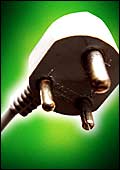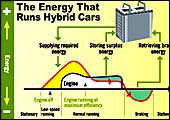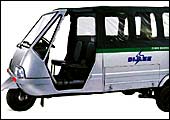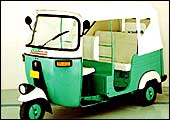| WHO'S DOING WHAT |
| CNG |
 Ashok
Leyland Ashok
Leyland
Tata Motors
M&M
Maruti Udyog
Hindustan Motors
Bajaj Auto
Eicher |
| AUTO-LPG |
 Tata
Motors Tata
Motors
Hindustan Motors
Maruti
Bajaj Auto |
| ELECTRICITY+ |
 Bajaj
Auto Bajaj
Auto
M&M
Maini Automobiles
Ashok Leyland
+This involves direct charging of a battery by connecting to
the electric mains and not the production of electricity through
the use of hydrogen, which is dealt with separately |
| ETHANOL |
 Tata
Motors Tata
Motors
M&M |
| BIO-DIESEL |
 DaimlerChrysler DaimlerChrysler
Tata Motors
Mahindra (Tractors) |
| HYBRID ENGINES |
 Tata
Motors Tata
Motors
TVS Motors |
| FUEL CELLS |
 And
other hydrogen-dependent energy sources including metal hydrides And
other hydrogen-dependent energy sources including metal hydrides
Tata Motors
Bajaj Auto
M&M/IOC |
Suhas
Kadlaskar loves to drive. That's why he jumped at the prospect of
test-driving an experimental Mercedes Benz on his employer's Pune
test track. An experimental Merc? Well, it was actually a regular
silver-grey C 220 powered by an experimental fuel-bio-diesel. And
Kadlaskar is no daredevil test driver; he's the Finance Director
of DaimlerChrysler India. He put the car through its paces on a
sunny spring afternoon in March 2004... taking it up to 80-90 kmph.
Bio-diesel gave a smoother ride than the regular fuel, emission
was 70 per cent lower, and there was significantly lesser noise
and vibration. Soon, he was out on Pune's streets, criss-crossing
the city for an hour at a more sober 60 kmph. "We only changed
the fuel tank and the fuel pipe; the modifications cost only Rs
2,000," he says. And not once did the car stall or lose power.
The conclusion: Bio-diesel fulfils all the technical specs; the
question marks relate to the logistics of availability and price.
But more on that later.
A thousand kilometres away, in Faridabad on
the outskirts of Delhi, is the 65-acre R&D centre of Indian
Oil Corporation (IOC). Inside the lush green campus, scientists
are working in partnership with Mahindra & Mahindra (M&M)
to create the country's first hydrogen-powered vehicle. But the
production of pure hydrogen-the most plentiful element on earth-for
fuel is not easy. The gas is inflammable-and its production, storage
and transport present huge difficulties. "The problem is that
hydrogen likes the company of other elements, so the trick is to
find an inexpensive way of separating hydrogen from other gases,
and do it in large quantities," informs N.R. Raje, Director
(Research, Refinery and Development), IOC. The present method of
producing hydrogen from water through electrolysis is very expensive
and, therefore, not financially viable on a large scale. Similarly,
the production of hydrogen from solid biomass is also too expensive
to make mass production viable. (See How They Stack Up).
This quest is more than a mere academic search
for a motoring Holy Grail. Under a mandate from the National Hydrogen
Energy Board (NHEB), set up in February 2004 by the Ministry of
Non-Conventional Energy Sources, IOC will have to make available
10 per cent hydrogen-blended CNG fuel in Delhi, Mathura and Faridabad
by June this year, and gradually increase it to 100 per cent by
2008 for three-wheelers, buses and cars. The goal: Creating fuelling
infrastructure for over 1,000 vehicles by 2008. IOC's R&D centre
has already successfully tested 10 to 30 per cent hydrogen-blended
CNG fuel on Fiats and Ambassadors. "It's ddifficult, but do-able,"
says M.S. Ramachandran, Chairman, IOC, and a member of NHEB.
That's exactly what Kadlaskar feels about bio-diesel.
DaimlerChrysler's Indian subsidiary, in collaboration with the Council
for Scientific Industrial Research and Hohenheim University, Germany,
is spending Rs 3.5 crore on a pilot project to grow Jatropha Curcas
oilseed plants on two small plantations in Gujarat's Bhavnagar and
Orissa's Behrampur districts. No, it's not entering the Indian agriculture
sector. Yet. The vegetable oil extracted from Jatropha Curcas reacts
with alcohol in the presence of a catalyst to produce bio-fuel.
Two Merc C 220s that drove 5,900 km across the country using bio-diesel
reported an average mileage of 12-13 km per litre, the same as for
diesel. The fuel will enter Phase II tests in 2005-06: Mercedes-Benz
plans to drive 10 cars over 30,000 km of difficult mountainous terrain
to further test the fuel. But to really benefit from this breakthrough,
India will need to generate 2.62 million tonnes of Jatropha (to
ensure a mere 5 per cent blend with diesel) by 2007. That will mean
bringing 2.2 million hectares under cultivation. "A significant
number of farmers will have to come on board," informs Kadlaskar.
| Bio-diesel gives a smoother ride
than the regular fuel; emission is 70 per cent lower; and there
is less noise and vibration. The question marks relate to the
logistics of availability and price |
 |
 |
| Maini's Reva: The first |
Meanwhile, an exclusive team of engineers and
scientists at Tata Motors' Engineering Research Centres in Pune
and Jamshedpur is working on an ambitious project to develop a zero-emission
fuel cell-powered bus as well as a hybrid electric car. Also in
the works are a bio-diesel-fuelled Indica and a project-in collaboration
with IOC-to evaluate the impact of 7 per cent and 10 per cent ethanol
on LCV 79, a commercial vehicle, Sumos and Safaris. Ethanol is oil,
distilled from sugarcane in India, and corn and rapeseed in other
parts of the world, which can be used to power internal combustion
engines.
Commenting on the fuel cell-powered bus, V.
Sumantran, Executive Director, Engineering Research Centre, Tata
Motors, says: "The on-board fuel cell power system in the bus
harnesses the chemical energy stored in hydrogen and converts it
to electrical energy, which drives the motor. The benefits: No pollution
and reduced noise and vibration." Its other project, the hybrid
electric car-a prototype is expected to be ready this year-is expected
to revolutionise the car industry. "It will be 20 per cent
more fuel efficient and also have much lower emission levels,"
he adds.
| Hydrogen-powered fuel cells have
to overcome cost issues; ethanol and bio-diesel production are
too insignificant to make a difference; and electricity-driven
cars are still in their infancy |
 |
| M&M's Bijlee: Another
electric vehicle |
Bajaj Auto has also jumped on to the alternative
fuel bandwagon. It launched ecorick, an electric battery-driven
auto-rickshaw, last month and hopes to sell around 1,200 vehicles
by September. "The new vehicle, which costs Rs 1.5-1.6 lakh,
is 50-60 per cent more expensive then the ordinary auto-rickshaw.
But over a five-year life cycle, it will be 10 per cent cheaper,"
says Tapan Basu, General Manager (Electric Vehicles), Bajaj Auto.
But the company will have to contend with difficulties related to
recharging of batteries, proper infrastructure and the higher initial
price. The company is trying to work around the first two problems
by tying up with petrol pump owners such as IOC, Bharat Petroleum
Corporation Limited and Hindustan Petroleum Corporation Limited
to store batteries, which auto-rickshaw drivers can use while their
own batteries are being charged. The company also plans to offer
this facility at Bajaj showrooms and at tyre shops owned by other
companies.
 |
|
|
| The future is here: Bajaj
Auto's electric three-wheeler (top), and Ashok Leyland's hybrid
electric vehicle (below) |
But scientists at Bajaj Auto are really banking
on the production of metal hydride as a fuel for three-wheelers.
Metal hydride absorbs hydrogen and when heated it releases hydrogen,
which is released as a fuel. The project is still in the experimental
stage and a final breakthrough will take some years.
Other players like the Chennai-based Ashok Leyland
and M&M, too, want a piece of the action. The former has already
created the eco-friendly battery/diesel-operated Hybrid Electric
Vehicle. And as mentioned earlier, M&M is going full steam ahead
with its quest for a vehicle that runs on alternative fuels-despite
the failure of Bijlee, its expensive battery-operated three-wheeler.
If these trials bear fruit, they will go a
long way in ensuring India's oil security by reducing its dependence
on foreign oil, and also provide huge relief on the balance of payments
front. In 2003-04, the country's oil import bill was nearly Rs 80,784
crore. According to IOC's Ramachandran, India's dependence on foreign
oil is likely to rise to 85 per cent by 2025, against 70 per cent
now.
However, the Holy Grail is not yet in hand.
Hydrogen-powered fuel cells have to overcome cost and infrastructure
issues; ethanol and bio-diesel production are still too insignificant
to make a difference; and electricity-driven cars are still in their
infancy. Yet, as Tata Motor's Sumantran says, the future is pregnant
with possibilities.
|
